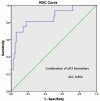Efficacy of multiple Biomarkers: NGAL, KIM1, Cystatin C and IL18 in predicting pregnancy related acute kidney injury
- PMID: 36694779
- PMCID: PMC9842994
- DOI: 10.12669/pjms.39.1.6930
Efficacy of multiple Biomarkers: NGAL, KIM1, Cystatin C and IL18 in predicting pregnancy related acute kidney injury
Abstract
Objective: Several biomarkers like NGAL, KIM-1, IL-18, and Cystatin C has been previously reported as reliable marker to predict AKI. However, their predictive accuracy varies widely. We aim to observe the efficacy of multiple markers, NGAL, KIM-1, Cystatin C and IL-18, in obstetric population who are at risk of developing AKI.
Methods: This prospective study was carried out between June 2021 to March 2022 at Department of Obstetrics & Gynecology Unit II, Ruth Pfau KM Civil Hospital and Sindh Institute of Urology & Transplant (SIUT), Karachi Pakistan. On women brought to OBGYN-ER with the diagnosis of hemorrhage (antepartum and postpartum), hypertension (pre-eclampsia and eclampsia) and sepsis. The urine samples and 3cc blood was collected at the time of admission, blood sample processed for biochemistry at time of admission and repeat blood samples for serum creatinine at 24 and 48 hours. Urine was stored at -80ºC and later evaluated for NGAL, KIM-1, Cystatin C and IL-18. Serum Cystatin C was also processed for the time zero sample. The biomarkers were tested using ELISA assays.
Results: A total of 149 women were included in the study, 83% of these women were non-booked. Twenty-six (17%) women developed AKI. Serum Cystatin C, urinary Cystatin C and urinary NGAL were found significantly raised in women who developed AKI. While KIM-1 and IL-18 were not raised to statistical significance in this population. However, urinary KIM-1 along with urinary Cystatin C were significantly raised in women with positive quick sequential organ failure assessment (qSOFA).
Conclusion: This study validates the use of serum and urinary Cystatin C and urinary NGAL as highly predictable biomarkers for the development of AKI and nullifies urinary IL-18 and KIM-1 in this regard.
Keywords: Acute Kidney injury (AKI); Cystatin C; IL-18; KIM-1; NGAL.
Copyright: © Pakistan Journal of Medical Sciences.
Conflict of interest statement
Conflict of Interest: None.
Figures
Similar articles
-
Assessment of biochemical markers in the early post-burn period for predicting acute kidney injury and mortality in patients with major burn injury: comparison of serum creatinine, serum cystatin-C, plasma and urine neutrophil gelatinase-associated lipocalin.Crit Care. 2014 Jul 14;18(4):R151. doi: 10.1186/cc13989. Crit Care. 2014. PMID: 25023056 Free PMC article.
-
Serum cystatin C, kidney injury molecule-1, neutrophil gelatinase-associated lipocalin, klotho and fibroblast growth factor-23 in the early prediction of acute kidney injury associated with sepsis in a Chinese emergency cohort study.Eur J Med Res. 2022 Mar 11;27(1):39. doi: 10.1186/s40001-022-00654-7. Eur J Med Res. 2022. PMID: 35272698 Free PMC article.
-
Biomarkers in neonates receiving potential nephrotoxic drugs.Eur Rev Med Pharmacol Sci. 2021 Nov;25(22):7078-7088. doi: 10.26355/eurrev_202111_27260. Eur Rev Med Pharmacol Sci. 2021. PMID: 34859872
-
Biomarkers for the diagnosis of sepsis-associated acute kidney injury: systematic review and meta-analysis.Ann Palliat Med. 2021 Apr;10(4):4159-4173. doi: 10.21037/apm-20-1855. Epub 2021 Mar 22. Ann Palliat Med. 2021. PMID: 33832292
-
Changes in Novel AKI Biomarkers after Exercise. A Systematic Review.Int J Mol Sci. 2020 Aug 7;21(16):5673. doi: 10.3390/ijms21165673. Int J Mol Sci. 2020. PMID: 32784748 Free PMC article.
Cited by
-
Efficacy of multiple Biomarkers: NGAL, KIM1, Cystatin C and IL18 in predicting pregnancy related acute kidney injury.Pak J Med Sci. 2023 Mar-Apr;39(2):628. doi: 10.12669/pjms.39.2.7494. Pak J Med Sci. 2023. PMID: 36950416 Free PMC article. No abstract available.
-
Biomarkers as Beacons: Illuminating Sepsis-Associated Hepato-Renal Injury.Int J Mol Sci. 2025 May 18;26(10):4825. doi: 10.3390/ijms26104825. Int J Mol Sci. 2025. PMID: 40429966 Free PMC article. Review.
-
Pregnancy-associated acute kidney injury - consensus report of the 32nd Acute Disease Quality Initiative workgroup.Nat Rev Nephrol. 2025 Sep;21(9):633-646. doi: 10.1038/s41581-025-00979-6. Epub 2025 Jul 18. Nat Rev Nephrol. 2025. PMID: 40681846
-
Causes and outcome of pregnancy related acute kidney injury.Pak J Med Sci. 2024 Jan-Feb;40(1Part-I):64-67. doi: 10.12669/pjms.40.1.7444. Pak J Med Sci. 2024. PMID: 38196455 Free PMC article.
-
Central Venous Pressure as a Predictor of Acute Kidney Injury in Cardiac Surgery: A Systematic Review of Observational Studies.Diagnostics (Basel). 2025 Feb 21;15(5):530. doi: 10.3390/diagnostics15050530. Diagnostics (Basel). 2025. PMID: 40075778 Free PMC article. Review.
References
-
- Naqvi R, Ahmed E, Sheikh R, Rizvi A. Obstetrical acute kidney injury:25 years'experience from nephrology care unit in Pakistan. Open Access Library J. 2015;2(08):1–7.
-
- KDIGO. Definition and classification of AKI KI Suppl. 2012;2:19–36. - PubMed
-
- Mishra J, Dent C, Tarabishi R, Mitsnefes MM, Ma Q, Kelly C, et al. Neutrophil gelatinase-associated lipocalin (NGAL) as a biomarker for acute renal injury after cardiac surgery. The Lancet. 2005;2(365 9466):1231–1238. doi:10.1016/S0140-6736(05)74811-X. - PubMed
-
- Nickolas TL, O'Rourke MJ, Yang J, Sise ME, Canetta PA, Barasch N, et al. Sensitivity and specificity of a single emergency department measurement of urinary neutrophil gelatinase-associated lipocalin for diagnosing acute kidney injury. Ann Intern Med. 2008;148(11):810–819. doi:10.7326/0003-4819-148-11-200806030-00003. - PMC - PubMed
LinkOut - more resources
Full Text Sources
Medical
Miscellaneous



